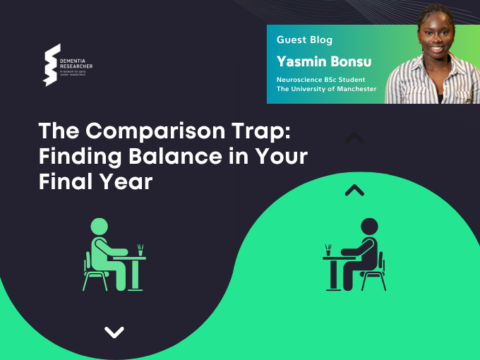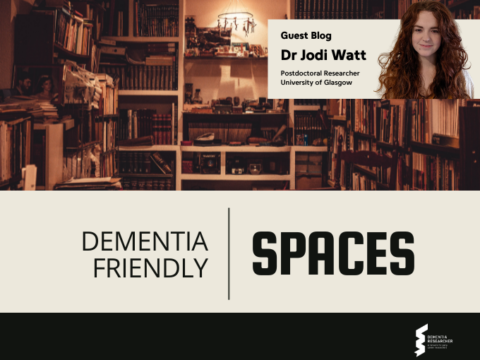Hi everyone, Hannah here and today I’m going to discuss OUTCOMES. I’m currently in my 3rd year of my PhD which focuses on health related quality of life as measured by the EQ-5D outcome measure. Coming from a clinical background (I’m a community pharmacist), I didn’t know a great deal about the different types of outcomes when I first integrated into academia and health economics. So today I’m going to explain all things outcomes related, hopefully this will be a helpful blog to those that may be finding this topic a little intimidating just like I did.
I’m going to be focusing on health outcomes, and wherever I use examples I will relate these to dementia studies/ trials. With that in mind, think about what studies and trials are trying to explore? In health, this will typically be an intervention – whether it’s pharmaceutical or not, with the goal of establishing whether this intervention is effective or derives benefits for its target user. For example, is a combined therapy of donepezil and memantine more effective at managing dementia symptoms than either drug alone? (This was actually assessed via the DOMINO-AD trial). In this example we want to know if there is a change in dementia symptom control – the way in which we capture this is the crux of health outcomes. But actually, what are health outcomes?
Firstly, it’s important to distinguish between outcomes from outputs – both of which are captured during studies and trials. Outputs describe the way in which we quantify healthcare delivery and are an important source of data e.g., number of AChEI’s prescribed or number of memory cafe sessions attended. Outputs are tangible, they are a way of defining the UNITS of service delivered. Outcomes, on the other hand, measure performance. Outcomes are often the result of a combination of outputs and can therefore provide a richer source of data, e.g., people living with dementia that attend a memory cafe once a week have an improvement in cognition as measured by MMSE. This example is totally made up by the way. It’s just to depict the level of detail that outcomes give in contrast to output data alone. This is not to say that outputs are not important, both data types are fundamental to health-related research.
The international consortium for health outcomes measurement (ICHOM) defines outcomes simply as the “the result of treatment that patients care about the most”. I really like this definition! Think about what you’d like to know when an intervention that could potentially benefit you is being studied? In the case of the DOMINO-AD trial – which focused on dementia symptom management, various outcomes were captured, the primary one being MMSE which is a measure of cognition – the hallmark indicator of dementia symptomology that we see again and again. They also captured activities of daily living (ADL) via the Bristol ADL scale and as secondary outcomes they measured neuropsychiatric disturbance (via the neuropsychiatric inventory) and quality of life via the DEMQoL-Proxy. All bases covered! This trial (in my opinion) is a really good example of considering what the patient may care about the most by including not only clinical markers of change, but also quality of life.
You may be finding that the terms “outcome” and “measure” are being interchangeably used. The key distinction is that the outcome is being measured by the measure. For example, cognitive score is the outcome – MMSE is the measure/ outcome measure; quality of life is the outcome, EQ-5D is the measure. Just thought I’d add this here as although this may seem obvious, it caught me a few times early on!

The international consortium for health outcomes measurement (ICHOM) mission is to unlock the potential of value-based healthcare by defining global Sets of Patient-Centered Outcome Measures that matter most to patients and driving adoption and reporting of these measures worldwide.
There are different types of health outcomes, and they mainly centre around the way in which they are measured. So firstly there are self-report measures, i.e., EQ-5D. These are typically captured via questionnaire format and rely on the respondent providing data about themselves. They can be seen as subjective, but they essentially measure they respondent’s own perception so can be ideal for certain types of analyses. You may have heard of patient-reported outcome measures or PROMs. These are a type of self-report measure in which the patient reports on their health state. They can be disease specific, e.g., DEMQoL or generic e.g., EQ-5D. Then we have performance-based measures. These require the participant to perform a set task or movement, e.g., the clock drawing test, which is commonly used in clinical dementia assessments. Although this type of assessment is seen to be more objective, it does not capture the patient’s perceptions or beliefs. Next, we have observer-reported measures – which are completed on behalf of the person by someone who regularly observes them on a daily basis, e.g., the Katz index of function; and finally, there are clinician-reported measures that are completed by a health-care professional. These involve the use of clinical judgement and reports on the patient’s behaviours or signs.
Okay so now we know the different types of health outcomes, but why does this all matter? As highlighted before, outcomes define the result of a treatment that matters most to the patient. Outcomes are not simply surveys or questionnaires. They are stringently validated tools that are integrated within trials and studies with clear purpose. The absence of outcomes would mean the reliance on outputs alone – which would not capture the aspects of treatments that are experienced by their users. We’d end up with purely quantitative service delivery data and that would be extremely rigid and detached.
It’s important also to consider WHICH outcomes to include, by understanding what matters most to the intervention user. As noted earlier, the DOMINO-AD trial included a whole range of outcome measures which was excellent. However, as in all studies, there is only one primary outcome. The primary outcome is the outcome on which the trial is powered. By this we refer to the statistical probability of detecting a difference between study groups when a true difference exists. Power is not only related to the primary outcome, but also to the sample size, as studies that are too small may not be able to identify important differences or changes in outcome measure scores. So again, with DOMINO-AD, the primary outcome was cognition as measured by MMSE. This seems like a good choice as the intervention under examination was pharmaceutical and has the aim of slowing down cognitive deterioration. But if the intervention was non-pharmacological, e.g., song and dance therapy for people living with dementia, would cognition still be an appropriate primary outcome? In cases like this we’d more likely want to assess the user’s quality of life. An outcome that is gaining more and more importance across all intervention types as we continue to understand what matters the most to people.
So, health outcomes are really important, and they are a fundamental part of health-related research and analysis. They are integrated into how we measure intervention success and ultimately impact policy decisions that are made down the line.
I hope that you have enjoyed reading this blog and thanks for tuning in! Hannah.

Hannah Hussain
Author
Hannah Hussain is a PhD Student in Health Economics at The University of Sheffield. As a proud third generation migrant and British-Asian, her career path has been linear and ever evolving, originally qualifying as a Pharmacist in Nottingham, then Health Economics in Birmingham. Her studies have opened a world into Psychology, Mental Health and other areas of health, and with that and personal influences she found her passion for dementia.

 Print This Post
Print This Post




